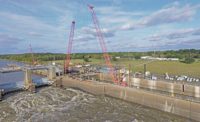 |
| Several months of rainfall swelled reservoir behind Prado Dam and caused seepage. (Photo courtesy of U.S. Army Corps of Engineers) |
More than 800 residents and 120 campers were allowed to return to their homes Jan. 14 after being evacuated the previous day from a community near the city of Corona in Riverside County, Calif., when an Army Corps of Engineers project manager noticed seepage on the downstream face of a rain-soaked Prado Dam. It was a precautionary action, says Dr. Fred-Otto Egeler, director of corporate communications for the Los Angeles District U.S. Army Corps of Engineers.
In addition to doubling the release of water from 5,000 cfs to 10,000 cfs, the Corps had the contractor working on improvements to the dams intake system, Riverside-based Yeager Skanska, Inc. cover the area with geotextile netting material and dirt.
Work had been halted on Monday because of the rain and will not begin again until the area dries out. Egeler says even if all of the $430 million of improvements now under way had been made, the seepage could still have occurred because of the sheer volume of rain and runoff the area experienced. The area on the border of Riverside and San Bernardino counties has received between 22 in. and 34 in. of rain since October, "close to what would be considered normal for an entire season," according to National Weather Service meteorologist Joe Dandrea, and as much as 12 in. during the second week in January.
Its an earthfill dam, Egeler explains. According to project descriptions, the dam has a clay core surrounded by fill material and topped with a layer of rock.
The Prado Dam currently gives 70-year flood protection, meaning a storm that could exceed the dams capacity and flood the surrounding urbanized area happens approximately every 70 years. In July, Yeager Skanska, Inc. was awarded a $65-million contract to begin the first of three phases of improvements scheduled to take as long as eight years. Plans include raising the height of the dam 30 ft, making outlet conduit improvements to increase flow to as much as 30,000 cfs, adding dikes to protect property and raising the height of the spillway 20 ft. The result will be an increased capacity of 140,000 acre-ft, affording 190-year flood protection. The construction company declineded to comment.
The dam is currently 106 feet high, 2,280 ft long and 30 miles upstream of the mouth of the Santa Ana River. It was built in 1941 after a devastating 1938 flood to provide protection and water storage.




Post a comment to this article
Report Abusive Comment